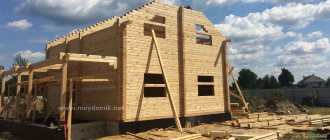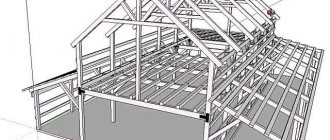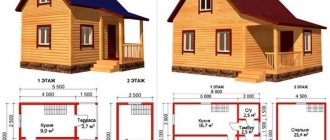Consequences of construction on an unprepared site
To cover as many aspects as possible and make sure that preparing land for building a house is a necessary undertaking, let's start with possible problems. These are the difficulties faced by owners of suburban areas who begin construction in a hurry and thoughtlessly:
- Complication of construction work.
- Rising prices for the services of transport companies and builders.
- Forced violations of construction technologies.
- Flooding of a construction site.
- Incorrect selection of type and calculation of the bearing capacity of the foundation.
- Premature shrinkage or even destruction of the foundation.
- Prolonged delivery deadlines.
- Damage to hidden communications existing on the territory.
- Lack of electrification power.
- Exorbitant fines for violating laws, rules and regulations.
These are just the main problems that you may encounter if you skip the preparatory work. To avoid the listed troubles and other difficulties, before starting construction it is necessary to carry out a whole range of relevant measures covered in this material.
Risks when purchasing a land plot
Rushing into a purchase often results in problems with registration, claims for the property of third parties, and other troubles. Below are just a few of the existing risk groups when purchasing a land plot:
Seller's dishonesty
It happens that in order to speed up the sale, the seller or agency conceals important circumstances. For example, the purchased plot may belong to the forest fund lands and cannot be sold in principle. In this case, you can only rely on rent.
Sometimes the seller does not warn the buyer about the category of land. For example, agricultural land cannot be used for industrial purposes, and the buyer must separately deal with the transfer of the site to another category. The land may be seized without permission, and there is simply no legal right to it.
The plot may be under arrest, a ban on sale, or sold several times (usually with old-type deeds without cadastral numbers). Fraudsters often use fake property certificates (duplicates, invalid, etc.), so the Russian Government has decided to abolish them. From 2021, only an extract from the Unified State Register will confirm ownership.
Careless paperwork
The compiled documents sometimes do not match the data in the cadastral passport in size. Often, when concluding an agreement, they forget about the interests of third parties (spouse) who have property rights to land if it was acquired during marriage. If a minor has rights to land, then the agreement requires the consent of guardians and trustees.
Inattention
There are cases when, after a transaction, the buyer receives a completely different plot. They showed one and sold another - worse. Be careful - make sure that the cadastral numbers in the documents correspond to the areas you are looking at on the ground. To be on the safe side, ask the seller for a cadastral passport, a delineation of the boundaries of the land plot on the ground, and use the KadastrRU mobile application with geolocation.
Is it worth buying a plot of land in a water protection zone?
Is it worth buying a plot of land in SNT
A short list of activities to prepare the site before construction
You can limit yourself to a minimum set of ten-point measures to significantly simplify the construction of a house and avoid problems. In particular, in the period between purchasing a plot and laying the foundation, you need to take care of the following points:
- Ensuring unimpeded access to undeveloped land.
- Advance zoning of the territory.
- Dismantling of unnecessary buildings.
- Removing unnecessary vegetation.
- Leveling the construction site.
- Geodetic works.
- Preparing the soil under the construction site.
- Solving communication issues.
- Fencing the territory.
- Electrification of the construction site.
Now it’s worth going through each of the listed points in more detail to get the overall picture and navigate the sequence of actions.
Recreation area for children
This is where things get a little more complicated. After all, ordinary gatherings are not enough for a child to relax. Children love to play, and that means installing some equipment. Modern play areas may contain:
- place for a sandbox;
- special device for a trampoline;
- small pool or stylish jacuzzi;
- a special complex for physical exercises.
Each item on this list has its own characteristics. So, the sandbox is very simple in its design. The budget option does not provide any wooden fencing at all. An ordinary bus or truck tire is filled with sand inside. If you are interested in a more complicated option, you can put together a rectangle or square of the required area. In this case, each board must be sanded, painted and, ideally, varnished. It is best to put only sand from rivers or lakes inside. And for a child, the development of fine motor skills and thinking in games will be an excellent incentive for further development. It is important to keep an eye out for debris within the sand itself. At night, this area can be covered with oilcloth or a special tabletop. The sandbox can also be equipped with a roof. Then sunstroke will be very rare.
With a trampoline everything is a little more complicated. Every child will love jumping on a sunny day. But the development of coordination and the musculoskeletal system requires proper installation of the structure and compliance with all design rules. Also, do not forget that everything should be protected at the edges with a soft mesh. It will prevent you from getting injured or falling out, and it’s much easier to hold on to.
Unobstructed access to the site
It should be remembered here that the house will not be built out of thin air, but from quite tangible building materials that require delivery to the construction site. If the purchased plot of land is located in an already developed settlement, on a street inhabited by other people, problems, as a rule, do not arise.
They appear when a plot of land is located on the edge of a populated area, or generally far beyond its borders. In this case, it is necessary to take care of how freight transport will bring sand, crushed stone, cement, wooden house kits and other materials to the construction site.
As part of organizing access to uninhabited areas, the following activities are carried out:
- the path is cleared of vegetation;
- the new road is strengthened with an embankment;
- significant level differences are removed that make it impossible for freight transport to travel;
- In places where rain and melt water may accumulate, drainage is installed.
Please be aware that any such work may require appropriate permits. You can get them from local authorities and authorities serving the area.
We improve the dacha area
If your site is already ready and divided into zones, but you want to arrange it in a new way - no problem, we will help you with advice on how to improve and decorate your site. Let's try to decorate the area with decor and other things made by ourselves.
- Landscape decorations - place different figures around the perimeter of your recreation area: decorative figurines, mini-waterfalls, or various figures made from concrete with your own hands.
- Decorative arches - install an arch made of metal, wood or plastic on your site. You can decorate this design in an interesting way and make it yourself.
- Lighting - place different flashlights, garlands or similar lighting elements around the area.
- Summer kitchen - create an outdoor dining area. In such a place you can have picnics and celebrate holidays in the summer. And if you like to spend your leisure time in the evening, place light bulbs or decorative candles around.
We have a lot of similar and similar ideas in stock; we have listed the most popular ones that you can make yourself or purchase at a low price.
We shared tips on how to properly zone and landscape a summer cottage with your own hands, with photo examples, so that you can draw on these ideas and add your own. Make your relaxation area as comfortable and cozy as possible.
Zoning
Along with choosing a place to build a house, answers to the following questions are sought:
- In which direction will rain and melt water go?
- In what place without violations will it be possible to install an autonomous sewer system?
- Where and at what distances from the house will the outbuildings (garage, bathhouse, shed) be located?
- How will communications be supplied to the house (water, electricity, gas)?
- Where will there be a garden, flower bed, vegetable garden, greenhouse and other areas?
You can avoid many difficulties in the future if you answer these questions before starting to build a house.
Development of economic and gardening areas
If the area is neglected, you will first need to clean it. Deal with the weeds, put those trees that you decide to leave in order, cut down and uproot the rest. If the area is already well maintained, it is better not to rush and change it gradually.
In any case, the main thing is not to overestimate your capabilities. This is a very common mistake - to overly speed up the process of arranging a site. You won’t be able to do everything at once, so it’s better to move forward gradually. First of all, it is worth developing the economic zone: installing a central water supply system, drilling a well, making a sewer system.
It is also worth creating conditions for future construction: installing temporary housing, temporary warehouses, and so on. For all this, it is worth finding a convenient place in advance, located so that it is convenient to import materials and carry out construction.
Garden and vegetable garden areas can be developed after construction is completed, before, and during - it depends on the specifics of the plan. Often these zones are combined into a common garden zone. It is preferable to place the garden and berry garden in open areas. The garden should not be located in a lowland, because there are cold winds and too much water during the spring flood - this has a bad effect on most garden trees.
In order to successfully develop a gardening area, you need to map out the future placement of all the crops on its plan and think over their location, taking into account the required distances. When the plan diagram is ready, you can proceed to preparing the soil. From the places allocated for construction, its top layer must be removed and transported to where it is planned to make plantings. Then you should level the soil, if the area is virgin, plow it.
For further planning, it is best to submit a soil sample for laboratory analysis, but you can do without it. So, you can check its acidity with litmus paper or vinegar. Acidified soil will need to be deoxidized; for this, lime, dolomite flour, ash, gypsum, chalk and other means are used.
If the soil is clogged, it is worth provoking the proliferation of weeds in order to destroy as much as possible and clean it. Fertilizers should be added to depleted soil - manure, humus, and so on. All these activities take time, so it is better not to plant anything in the first year, otherwise you will then have to constantly fight weeds and other problems.
Vegetation control
As a general rule, if there are fruit or ornamental trees and they fit into the current zoning, then it is best to leave them. All this takes a long time to grow and, if you remove everything at the root, you will have to live on bare ground for many years.
Naturally, trees that are in the way are removed. Which of them will interfere is described in detail in the relevant standards. Do not rush to remove and burn the resulting wood. Perhaps there is a bathhouse in the plans, which will really need firewood.
Reasons for suspending registration of a land plot
The reason for restricting rights may be the following:
- Court order to seize property;
- Private or public easement on real estate;
- A mortgage in which land serves as security for the payments;
- Collateral obligations;
- The seller's outstanding tax debt;
- Trust management of property;
- Lease of land, including special purpose (protection and sanitary zones, forestry and agricultural land), which are of interest to the state;
- Concession agreement (an agreement with the state on the paid transfer of land for a certain period of use).
How to register the assignment of the right to lease a land plot
Geodesy
As part of this stage, the following tasks are solved:
- Determination of soil composition.
- Determination of soil density.
- Calculation of soil bearing capacity.
- Determination of the depth of groundwater.
In the future, all this information will help to correctly determine the foundation, arrange a sewer system, a well, a borehole, a cellar, and so on.
How to reclaim an overgrown area
We talk about the experience of developing twenty acres, which just a year ago were covered with old stumps, as well as impenetrable thickets of bushes and raspberries.
If the joy of a purchase at the sight of acres overgrown with weeds or viscous clay gives way to a headache, then it’s time to sit down at the table or on a stump and outline a plan of action. Working without a plan is unproductive and ineffective.
Let's start by working on the mistakes that slow down the pace of land development
- The desire to do everything on your own. Trips “to the dacha” with an ax and a chainsaw in the trunk and a grueling weekend of uprooting stumps (if you don’t have enough experience, then one tree frame sticking out of the ground will take two days) can forever turn you away from the idea of becoming a homeowner. Moreover, there are plenty of workers from neighboring countries who will happily take on such work.
- Trying to solve everything with money. The local forestry enterprise will tell you the amount for which local craftsmen will “smooth out” the area with a bulldozer and bring in an excavator, through which mountains of stumps, stones and other debris will be loaded into dump trucks and taken away in a direction unknown to you. I'm sure you won't be happy with this number. In addition, after such a rough operation, your site may turn into a quagmire, and you will have to dig out wood remains from the ground for a long time and clear away rubble.
- Excavation work with unsuitable or low-quality tools and equipment reduces the pace tenfold. A dull ax and a flimsy shovel will not allow you to process even a few square meters, and a lightweight walk-behind tractor, recommended by the sellers of a specialized store as an expensive toy, will become tightly entangled in the roots.
- And finally, the most important thing: working without a plan is completely wasted money. As soon as they dismantled one corner, they filled up another. They forced the workers to cut out the forest, and then you plant a new one...
From specialized “translated” manuals on the basics of landscape design, you can usually learn that soils are mainly “heavy” clayey and “light” sandy. The former require the addition of sand, the latter - clay, and both also require the addition of huge quantities of organic matter. For us, these rules are not always relevant. The North-West of Russia has its own specifics, namely: we have such an irreplaceable natural resource as humus - at least export it. In Soviet times, gardeners and novice dacha owners were most often offered to develop impassable swamps rather than arable land. Today, such difficult-to-develop plots have ended up on the secondary land market. The range of land offers for private homeowners has grown from yesterday's state farm fields with soils depleted and sometimes spoiled by the uncontrolled use of chemicals, which are overgrown with impenetrable thickets with a thickness of fallen and half-rotten trunks and huge boulders, copses, which, due to illiterate reclamation, are rapidly turning into a swamp... But nothing stops homeowner candidates.
In today’s review, we do not consider the problems of implementing the master plan for a cottage or dacha village: issues of land reclamation, electrification, as well as the construction of access roads are the responsibility of the development companies selling the plots, as well as the competence of the boards of gardening partnerships and the DNP. And if their activity leaves much to be desired, you will have to mobilize your neighbors and engage in social work. Let's consider the issues that have to be resolved independently, and in the near future after purchasing the land. Let's start with the boundaries of your site.
Neighbors and borders
It often happens that the emergence of new landowners stimulates the “old-timers” to revise the boundaries of the territory. When the question arises of where to put the fence, they try to win a piece of territory from you by hook or by crook. A little trick: if the fence posts are shifted a meter deep into your territory, and the length of the plot is fifty meters, consider that you have donated fifty meters of land. And if the plot you purchased stood abandoned for many years, while the neighbors worked tirelessly to develop the territory, there is a high probability that they could not resist the temptation to grab a piece of “nobody’s” land. This happens all the time and sometimes leads to protracted conflicts. But starting the “development of virgin lands” with quarrels is not the best option, especially since many issues will have to be resolved jointly with neighbors one way or another. And in most cases, the conflict can easily be resolved through civilized means.
To carry out the purchase and sale transaction of a plot, your predecessors collected many documents, the main one of which is a certificate of assignment of a cadastral number. A cadastre is a document that unambiguously defines a site: its area, category, boundaries. And if you purchased a plot, it means it already has a cadastral number. This also means that the boundaries of the territory were agreed upon with your neighbors, and there is documentary evidence of this in the land surveying file: they either signed the protocol for the approval of boundaries themselves, or (if they avoided this in every possible way) were notified of the upcoming procedure by telegram. Thus, in order to determine the real boundaries of your territory, it is enough to invite the surveyors who formed the case to put up boundary signs that correspond to the previously completed cadastral survey. This service is paid; on average, installing one boundary sign costs 500 rubles, and in the simplest case, when the site is a quadrangle, four of them are needed.
If you were told that the pegs had already been installed, this should not mislead you, because rearranging them after the specialists leave the site is a favorite pastime of some not entirely decent citizens. We shouldn’t immediately blame our neighbors for “theft”; our task is to try to avoid conflicts. Make it clear that an area with incorrect boundaries is a source of legal problems primarily for them.
The boundaries of your territory are known. We are not putting up a fence yet - it will only get in the way when dismantling perennial rubble and windbreaks; we mark the boundaries with pegs and ropes.
Fencing
Many leave this stage for later, and as a result are faced with theft of building materials. Even a symbolic fence made of cheap corrugated sheets will significantly reduce the risk of theft of your still movable property in the form of expensive building materials. If the plans include a permanent fence made of concrete sections or bricks, it might be worth starting to inhabit the area with this.
conclusions
- Due to the pace of infrastructure development in urban outskirts, the cost of land plots is growing rapidly, but along with the price, risks are also growing;
- To purchase on your own, you need to have a minimal understanding of legal intricacies and have free time to prepare documents;
- There is a threat of repeated resale of property rights, according to old-style deeds, as well as resale of land plots without cadastral numbers, therefore the legal purity of the property is checked before purchase in advance;
- The easiest and fastest way to document the existence of rights of the owner, as well as check the presence of encumbrances on the land plot (arrest, pledge, mortgage, etc.) is to order an extract from the Unified State Register of Real Estate.
Electrification
Modern construction is impossible without the use of technology, equipment and tools. All this requires power from electricity. Moreover, the power of professional equipment is no joke, and it is not always so easy to provide. Therefore, you should not invite a construction company to the site before the electrification of the site is completed.
Many construction companies can easily do without electricity. For this they have mobile generators. But such a service is already paid for separately, and is not so cheap.
How to register the purchase of a land plot from a legal entity
Individuals and legal entities, as well as state and municipal entities can participate in land purchase and sale transactions. However, legal entities will have to collect an additional package consisting of constituent documents, minutes of the meeting of founders with a decision on the transaction, a resolution of the local administration on the transfer of land, etc.
How to draw up an agreement between a legal entity and an individual
A purchase and sale agreement can be concluded between two individuals, between an individual and a legal entity, and also between two legal entities. There are no restrictions here. There are no mandatory preparation requirements, but the following is important:
- In the “Subject of the agreement” section, you should describe the land plot in as much detail as possible. Don’t be afraid to write too much - the more data you have about the land, the lower the likelihood of a dispute in the future. Indicate the area of the plot, address, cadastral number, target category, registration certificate data, etc.;
- Encumbrances on the site, if any, should be described in detail. The buyer must be aware of all restrictions and possible claims to the site by third parties;
- The agreement must be registered with Rosreestr.
The contract should not contain the following conditions:
- about the seller’s right to buy the plot;
- restrictions on the use of land after purchase;
- the seller's disclaimer of liability if claims from third parties are made against the site.
What documents will be required
When a legal entity purchases land from an individual, the latter must provide:
- Extract from the Unified State Register of Real Estate;
- A document evidencing rights to land (authority decisions on allocation, purchase and sale agreement from the previous owner, etc.) or a registration certificate of ownership from the regional representative office of the Federal State Property Fund indicating the owner, category of land, area of the plot, address, phone number cadastre;
- Cadastral passport of a land plot with number, address, area, cadastral value, category of land, type of use, information on registration of rights;
- Passport of a citizen of the Russian Federation.











